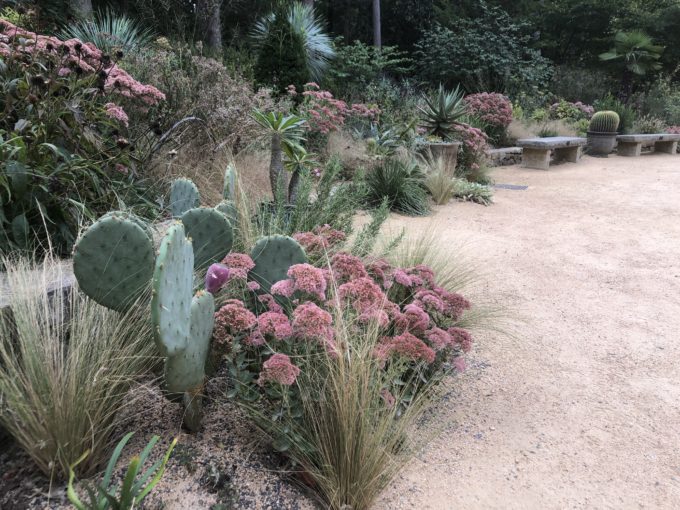Water Conservation & Xeric Gardening
All of the public gardens that we visited on our first company trip since 2019 to North Carolina took advantage of xeriscaping* and/or water conservation in one way or another. After the terribly dry summer that we’ve had this year, I was relieved to see such lush and varied solutions to some of the challenges our climate is throwing at us.
Mary Duke Biddle Rose Garden At Duke Gardens
Many of the roses in this garden were hit hard by the incurable Rose Rosette Virus, and their removal led to a redesign in 2019. The resulting plant selection was inspired by the Dry Garden of Hyde Hall, and the Scree and Gravel Gardens at Beth Chatto’s in the UK. Now a few roses remain, but are now accompanied by an assortment of drought tolerant, sun loving plants.
Coneflower seed heads were standing between the roses, using them as buttresses by our mid-September visit. Their pinkish-purple flowers have been replaced by the rosy hues of flowering grasses and Sedum, and the mauve fruits of Prickly Pear. The frosty-blue, glaucous foliage of these plants and others (Agaves, Lamb’s Ear, and Cycads) add to a cool, ethereal palette.
The plant groupings spilled out of the low walls of the rose garden and into pots dotted throughout the circular courtyard and up the steps of Roney Fountain. They’ve even been incorporated into the grit walkway where visitors are no longer separated from them by walls or edgings. This added a new level of intimacy and immersion that I had not yet experienced in any public display or botanical garden before and an extra, often underutilized layer in the profile of a garden.
North Carolina Botanical Garden Courtyard Garden
In addition to utilizing xeriscaping in its use of drought tolerant plants, this garden also houses 8 cisterns for rainwater sequestration, and its LEED Platinum Certified education center employs an assortment of water conservation methods.
Scree Garden at J.C. Raulston Arboretum and Juniper Level, the display gardens of Plant Delights Nursery
To prevent drought tolerant plants from rotting after excessive rainfalls, each of these gardens took advantage of one or more specialized gravels, such as scree, decomposed granite, or permatill. Scree and decomposed granite are types of weathered, crumbly gravel. Often added to beds to improve drainage, they were also used as a path material. In hardscaping applications, an additive can be used to prevent movement on slopes or improve stability under heavy foot traffic and wheelchairs. Permatill, a similar material, is made from slate found locally in North Carolina. When cooked to 2000º F it expands. The tiny pores created by the expansion process serve as reservoirs for nutrients and water that are available to the plant, while the material as a whole offers improved air and water permeability.
*Xeric Gardening (or xeriscaping) is a method of low maintenance gardening that involves the use of drought tolerant plants capable of surviving off of an area’s naturally occurring precipitation with little or no supplemental irrigation.
